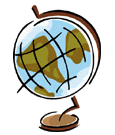Learn about the history of Central America and the Caribbean.
 Objectives:
Objectives:
- Students will be able to describe the location and geography of Central America and the Caribbean.
- Students will understand that Christopher Columbus first landed in the West Indies on one of the islands that are now the Bahamas.
- Students will be able to describe the mixture of people that live in Central America and the Caribbean.
- Students will be able to identify Haiti as the only country to gain independence via a successful rebellion of slaves.
- Students will be able to describe the climate and natural dangers of Central America and the Caribbean.
Suggested Grades:
4th Grade – 5th Grade – 6th Grade
Procedure:
- Read lesson or have students read it silently.
- Have students answer the questions on the worksheet.
- Discuss answers to questions.
Lesson Excerpt:
Central America is a narrow piece of land, called an isthmus, which links North America and South America. The eastern shore of Central America is along the Caribbean Sea. There is a long chain of islands in the Caribbean Sea known as the West Indies. The climate is always warm in this region of the world because it is near the equator. There are two seasons – a rainy season that lasts from May to November and a dry, sunny season during the rest of the year.
In 1492, when Christopher Columbus sailed west from Spain, the first place he landed was a Caribbean island that is now part of the Bahamas. He named the island San Salvador. Spanish colonists came to the Caribbean islands and Central America to grow tropical crops like sugar, coffee and cacao beans (which are used to make chocolate). The colonists enslaved the natives who lived in the region. Later, they brought slaves from Africa to work for them as well. Today, many people from the Caribbean and Central America can trace their family roots to Africa.
 Objectives:
Objectives: